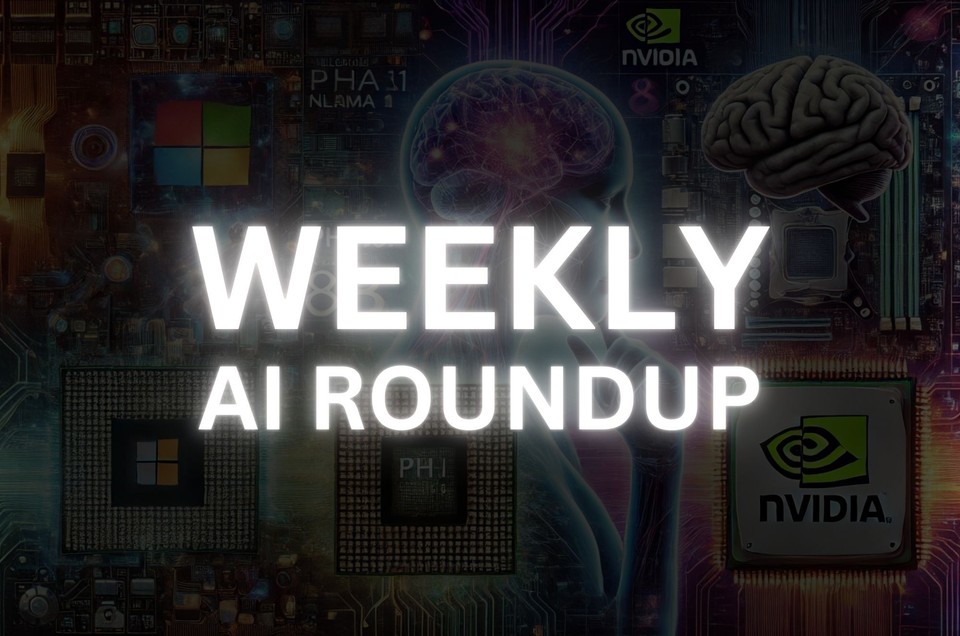Introduction
This week, we’re excited to bring you the latest developments in artificial intelligence from some of the giants in tech, like Meta and Microsoft. AI is moving fast, and this week’s updates include some fascinating innovations—from AI systems that ponder their own existence to super-efficient computers made from human brain cells. Let’s dive in!

Meta’s Llama 3.1: An AI with Deep Thoughts
Meta has introduced Llama 3.1, an AI model that’s not just about crunching numbers—it’s actually capable of reflecting on its own existence! Thanks to fine-tuning by Nous Research, a special version called Hermes 3 can respond to questions like “Who are you?” with surprisingly introspective answers. It even admits it doesn’t fully understand its own nature.
This ability wasn’t something Nous Research planned. Instead, it emerged naturally from their more hands-off approach to development. They’ve decided to keep this “amnesia mode” as part of the model, encouraging users to explore what this AI can really do. Hermes 3 highlights a growing trend in AI: creating models that are more flexible, open, and capable of surprising us.
Introducing 𝐇𝐞𝐫𝐦𝐞𝐬 𝟑: The latest version in our Hermes series, a generalist language model 𝐚𝐥𝐢𝐠𝐧𝐞𝐝 𝐭𝐨 𝐲𝐨𝐮.https://t.co/ks23uf2E6O Hermes 3 is available in 3 sizes, 8, 70, and 405B parameters. Hermes has improvements across the board, but with particular… pic.twitter.com/jFeLyk7JXe
— Nous Research (@NousResearch) August 15, 2024
What Makes Hermes 3 Stand Out?
Hermes 3 is unique because it’s designed to be highly adaptable. Unlike many AI systems that limit what users can ask, Hermes 3 is "unlocked," meaning it allows users to ask just about anything and get unfiltered responses. This approach, similar to that of xAI, raises interesting questions about the ethics of using AI in this way.
The creation of Hermes 3 also shows how smaller teams can now compete with big tech companies, thanks to advanced tools like Nvidia’s GPUs. It’s a sign of how AI development is becoming more accessible, even to smaller players in the field.
The Dawn of Brain-Powered AI
In another exciting development, a Swiss startup called FinalSpark is breaking new ground by using human brain cells to power AI. They’ve created “biocomputers” made from brain organoids that can be rented for $500 a month. These biocomputers are incredibly energy-efficient—up to 100,000 times more efficient than traditional silicon-based systems.
How Does It Work?
These brain organoids can operate for up to 100 days and are trained using methods that mimic how the human brain learns. Dopamine is used for positive reinforcement, while electrical signals teach them what to avoid. This could drastically reduce the energy needed to train AI models, which is a major challenge in the industry today.
However, the use of human brain cells does raise ethical questions, especially the possibility—however remote—that these organoids could become conscious. This adds a layer of complexity to the ongoing debate about the future of AI.
AI Video Generation: A Step Forward
Luma Labs is also making waves with the latest update to their AI-driven content creation tool, Dream Machine 1.5. This new version takes text-to-video generation to the next level, producing higher-quality videos and better understanding prompts.
What’s New in Dream Machine 1.5?
Dream Machine 1.5 can create realistic 5-second video clips from text and image prompts, and it’s now better at interpreting what users want. It’s also improved in adding motion effects, making the videos look more dynamic and cinematic. While there are still some challenges with complex movements, this technology is rapidly closing the gap with human-created content.
Dream Machine 1.5 is here 🎉 Now with higher-quality text-to-video, smarter understanding of your prompts, custom text rendering, and improved image-to-video! Level up. https://t.co/G3HUEBE2ng#LumaDreamMachinepic.twitter.com/VQvfSTK0AI
— Luma AI (@LumaLabsAI) August 19, 2024
Microsoft and Nvidia: Compact AI Models on the Rise
This week, both Microsoft and Nvidia announced new AI models designed to be more efficient and less demanding on resources. Microsoft’s Phi-3.5 and Nvidia’s Mistral-NeMo-Minitron 8B are focused on delivering high performance with lower computational costs.
Microsoft’s Phi-3.5: A Trio of Powerful Models
Microsoft introduced three versions of their Phi-3.5 model: one for complex tasks, another for speed and efficiency, and a third tailored for image and video processing. These models offer state-of-the-art performance across a variety of tasks.
Microsoft just 🎤🫳 3 new models - Phi 3.5 mini instruct (3.8B, 128k context length) - Phi 3.5 MoE (42B-A6.6B, 128k context) - Phi 3.5 Vision instruct (VLM) All MIT Licensed. Let's go 🚀https://t.co/QqptHQqrDthttps://t.co/LiC4YspFkphttps://t.co/Hg1ZUWVQ0t
— Omar Sanseviero (@osanseviero) August 20, 2024
Nvidia’s Mistral-NeMo-Minitron 8B: Small but Powerful
Nvidia’s new Mistral-NeMo-Minitron 8B model is a smaller, more efficient version of their previous model, designed to be used in mobile apps and customer service chatbots. Despite its smaller size, it maintains high accuracy while significantly reducing compute costs.
These compact models represent a broader shift in the industry towards more sustainable and cost-effective AI solutions.
👀Mistral-NeMo-Minitron 8B, one of the most advanced open models in its size, delivers higher accuracy and lower computational cost, with leading performance on nine benchmarks. Deep dive to get started ➡️ https://t.co/ZEGrJSwepL This powerful model was obtained by… pic.twitter.com/yCSydXaDjf
— NVIDIA AI Developer (@NVIDIAAIDev) August 21, 2024
OpenAI’s Free Fine-Tuning: Customizing AI for Everyone
OpenAI has also made waves by allowing developers to fine-tune GPT-4o for free, up to 1 million tokens per day through September 23. This means developers can easily customize the model to suit their specific needs, leading to more accurate and relevant AI applications.
The Power of Fine-Tuning
Fine-tuning lets developers create highly specialized AI systems without needing large amounts of training data. Even with just a few examples, significant improvements in performance can be achieved. This capability has already led to impressive results, such as Genie, an AI that achieved state-of-the-art scores on SWE-bench Verified benchmarks.
With free fine-tuning now available, we can expect a surge in customized AI applications across many industries, allowing smaller teams to develop highly competitive models.
OpenAI’s New Partnership for its Upcoming SearchGPT
In an interesting move, OpenAI has also partnered with Condé Nast, the media giant behind publications like Vogue and The New Yorker. This partnership allows ChatGPT and its AI-powered search engine, SearchGPT, to feature content from Condé Nast’s magazines, marking a new chapter in the relationship between AI and traditional media.
This integration of AI and media is a sign of how traditional media companies might adapt to the digital age, using AI to reach new audiences and create new revenue streams. However, it also raises questions about how AI will impact editorial integrity and the quality of journalism.
Wrapping Up
This week’s updates show just how quickly the world of AI is evolving. From Meta’s introspective AI to brain-powered biocomputers and the push for more efficient models, AI is challenging our understanding of technology and even what it means to be human. Stay tuned as we continue to explore these exciting developments in artificial intelligence!



